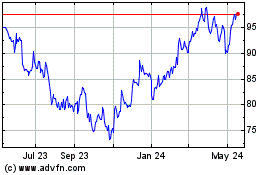3 Companies Drowning in Debt - Investment Ideas
November 18 2013 - 4:08PM
Zacks
Following the bursting of the housing bubble and subsequent
financial crisis, debt has become somewhat of a 4-letter word to
many Americans. And while there are many benefits to debt-free
living for households, in the corporate world, debt is often
desirable.
The Benefits of Debt
In order for a company to grow, it must finance
that growth. This can come from retained earnings, issuing debt, or
by selling new shares of stock. While many investors seem to prefer
debt-free balance sheets, there are actually quite a few benefits
for a company to have some debt:
- It's cheaper than equity financing.
- Interest payments are tax deductible, while dividends paid to
shareholders are not.
- Issuing debt does not dilute shareholder value, unlike issuing
new equity.
Too Much of a Good Thing...
Of course too much debt can be crippling for a
company if business turns south. The more debt financing a company
uses, the greater its risk of bankruptcy.
If a company is distressed, you can bet that those
interest payments will get sent out before any dividend checks. And
in the event of a bankruptcy, debtholders have first claim on
company assets over stockholders.
So what's the right balance of debt and equity for
a company? Ideally, a company should operate around its optimal
capital structure - where its weighted average cost of capital
(WACC) is minimized. But finding the right amount of debt-to-equity
may be more art than science.
There are ways, however, for investors to tell if a
company is carrying too much debt. And that involves looking at
various financial ratios.
Liquidity vs. Solvency
Two of the best types of ratios to consider are
liquidity and solvency ratios.
Liquidity is a measure of the firm's ability to
meet its short-term obligations. Solvency is a measure of the
firm's ability to meet its long-term obligations. It's more of a
measure of the firm's long-term survival.
Two of the most common liquidity ratios are the
Current Ratio [Current Assets / Current Liabilities]
and the Quick Ratio [(Current Assets - Inventories) /
Current Liabilities]. These will vary across industries, so it's
important to compare them to their peers. But the higher the ratios
the better.
The most common solvency ratios are the
Interest Coverage Ratio [Operating Income / Interest
Expense] and the Debt/Equity ratio. The more
leveraged a company is, the lower its Interest Coverage Ratio will
be and the higher its D/E ratio will be. Again, these will depend
on what industry a company operates in. Capital-intensive
businesses will typically carry larger amounts of debt on its
balance sheet. Again, it's important to consider industry
averages.
3 Companies Drowning in Debt
I ran a screen for companies with poor liquidity
and solvency ratios. While this doesn't necessarily signal imminent
bankruptcy, these four companies all appear to be cash-strapped and
overleveraged at the moment. And that's a dangerous place to be,
especially if business doesn't improve.
Here are 3 names from the list:
Windstream Holdings (WIN)
Current Ratio: 0.76
Quick Ratio: 0.57
Interest Coverage Ratio: 1.34
Debt/Equity: 10.25
Emeritus Corp (ESC)
Current Ratio: 0.71
Quick Ratio: 0.54
Interest Coverage Ratio: 0.61
Debt/Equity: 22.88
Casella Waste Systems (CWST)
Current Ratio: 0.76
Quick Ratio: 0.65
Interest Coverage Ratio: 1.02
Debt/Equity: 31.44
The Bottom Line
For corporations, a prudent amount of debt can be
beneficial. But too much debt will increase the risks of bankruptcy
and put shareholders at risk. These 3 companies appear to be in
over their heads at the moment.
Todd Bunton, CFA is the Growth & Income
Stock Strategist for Zacks Investment Research and Editor of the
Income Plus Investor service.
Want More of Our Best Recommendations?
Zacks Executive VP, Steve Reitmeister, knows when
key trades are about to be triggered and which of our experts has
the hottest hand. Then each week he hand-selects the most
compelling trades and serves them up to you in a new program called
Zacks Confidential.
Learn More>>
CASELLA WASTE (CWST): Free Stock Analysis Report
EMERITUS CORP (ESC): Free Stock Analysis Report
WINDSTREAM HLDG (WIN): Free Stock Analysis Report
To read this article on Zacks.com click here.
Zacks Investment Research
Casella Waste Systems (NASDAQ:CWST)
Historical Stock Chart
From Jun 2024 to Jul 2024

Casella Waste Systems (NASDAQ:CWST)
Historical Stock Chart
From Jul 2023 to Jul 2024
